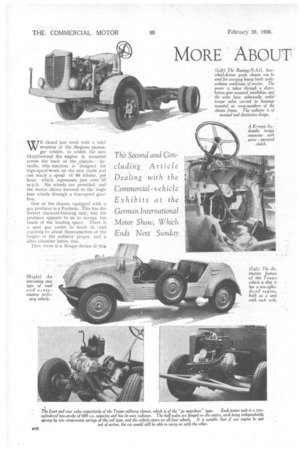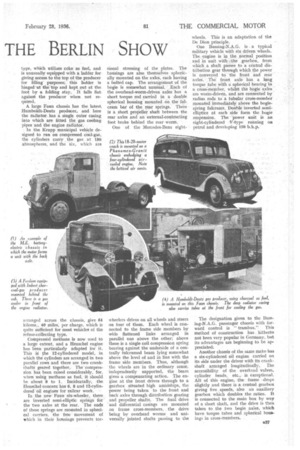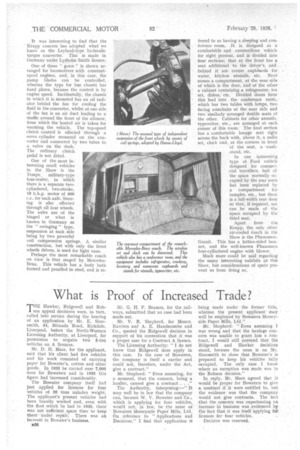MORE ABOUT' THE BERLIN SHOW
Page 50

Page 51

Page 52

If you've noticed an error in this article please click here to report it so we can fix it.
WEclosed last week with a brief mention of the Magirus passenger vehicle, in which the new 12-cylindered fiat engine is mounted across the back of the chassis.'..: Acr
tually, this machine ,,
is designed for high-spced*,ork on the new. roads and can reach .a speed Of -90 kiloms. per hour, which . represents just over -57 m.p.h. Six .wheels are provided,and the motor drives forward to the bogie four Wheels through a four-spied gearbox.
One of the chassis equipped with a gas producer is a Fordson. This has the Imbert charcoal-burning unit, but the producer appears to us to occupy too much of the loading space. There is a neat gas cooler in front of, and reaching.to. about threejquarters of the heightof the radiator -proper, and a
filter chamber beloW this. Then there is a Krupp device Of this
type, which utilizes coke as fuel, and is unusually equipped with a ladder for giving access to the top of the producer for filling purposes; this ladder is hinged-at the top and kept out at the foot by a folding stay. It falls flat against the producer when not required.
A large Faun chassis has the latest. Humboldt-Deutz producer, and here the radiator has a single outer casing into which are fitted the gas cooling pipes and the engine radiator.
In the Krupp municipal vehicle designed to run on compressed coal-gas, the cylinders carry the gas at 180 atmospheres, and the -six, which are
arranged across the chassis, give 64 klionis., 40 inflee; per charge, which is quite sufficient for most vehicles of the refuse-collecting type.
Compressed methane is now used to a large extent, and a Henschel engine has been particularly adapted for it. This is the 12-cy/indered model, in which the cylinders are arranged in two parallel rows and there are two crankshafts geared together. The -compression has been raised considerably, for, when using methane as fuel, it should be about 8 to 1. Incidentally, the Henschel concern has 6, 8 and I2-eylindered 'oil engines for railcar work.
In the new Faun six-wheeler, there are inverted semi-elliptic springs fOr the two axles at the rear. The ends of these springs are mounted in spherical carriers, the free movement of which in their housings prevents tor
sional stressing of the plates. The housings are also themSelves spherically mounted on the axles, each having a bolted cap. The arrangement of the bogie is somewhat unus-ual.. Each of the overhead-worm-driven axles has a short torque rod carried in a double spherical housing mounted on the fulcrum bar of the rear springs. There is a short propeller shaft between the rear axles and an external-contracting foot brake behind the rear worm.
One of the Mercedes-Benz eight.
wheelers drives on all wheels and steers on four of them. Each wheel is connected to the frame side members by wide flattened links arranged in parallel one above the other; above these is a single coil compression spring bearing against the underside of a centrally fulcrumed beam lying somewhat above the level of and in line with the frame side members. Thus, although the wheels are in the ordinary sense, independently supported, the beam gives a compensating action. The engine at the front drives through to a gearbox situated high amidships, the power being taken to the front and back axles through distribution gearing and propeller shafts. The final drive and differential casings are mounted on frame cross-members, the drive being by overhead worms and universally jointed shafts passing to the wheels. This is an adaptation of the De Dion principle.
One Bussing-N.A.G. is a typical military vehicle with six driven wheels. The. engine is in the normal position and in unit with :.-the gearbox, from Which a shaft passes to a central distiibution gear through which the power is Conveyed to the front and rear axlei. The front axle has a long torque tube with a spherical bearing in a cross member whilst the bogie axles are worm-driven, and are connected by radius rods to a tubular cross-member mounted immediately above the bogiespring fulcrums. Double inverted semielliptics at each side form the bogie suspension. The power unit is an eight-cylindered V-type running on petrol and developing 150r ti.h.p.
The designation given to. the Bussing-N.A.G. passenger chassis with forward control is " trambus.". This method of construction has hitherto not been very popular in Germany, but its advantages are beginning to be appreciated..
Another chassis of the same make has a six-cylindered oil engine, carried on its side under the driver with its crankshaft arranged longitudinally. The accessibility of the overhead valves, cylinder heads, etc., is. exceptional. Aft of this 'engine, the • frame drops slightly and there is a. central gearbox giving five ,speeds, also an auxiliary gearbox which doubles the ratios. It is connected to the main box by way of a short shaft, and the drive is then taken to the two bogie axles, which have torque tubes and spherical housings in cross-members. It was interesting to find that the Krupp concern has adopted what we know as the Leyland-type hydraulic torque converter. This is made in Germany under Lysholm Smith licence.
One of these " gears" is shown arranged for locomotives with constantspeed engines, and, in this case, the pump blades can be controlled, whereas the type for bus chassis has fixed plates, because the control is by engine speed. Incidentally, the chassis in which it is mounted has an oil radiator behind the fan for cooling the fluid in the converter, whilst at one side of the fan is an air duct leading to a muffle around the front of the silencer, from which the heated air is taken for warming the vehicle. The top-speed clutch control is effected through • a servo cylinder mounted on the converter and connected by two tubes to a valve on the dash. The ordinary clutch pedal is not fitted.
One of the most interesting small vehicles• in the Show is the
Tempo military-type four-seater, in which there is a separate twocylindered, two-stroke, 19 b.h.p. motor of 600 c.c. for each axle. Steering is also effected through all four wheels. The axles are of the hinged or what is known in Germany as the " swinging " type, suspension at each side being by two powerful coil compression springs. A similar construction, but with only the front wheels driven, is used for light vans. Perhaps the most remarkable coach on view is that staged by Mercedes73enz. This vehicle has a body both framed and panelled in steel, and is re
The rearmost compartment of the remarkable Mercedes-Benz coach. The wireless
set and clock can be discerned. This vehicle also has a conference room, and the equipment includes refrigerator, crockery, lavatory and numerous cupboards and stands for utensils, typewriter, etc. ferred to as havinga sleeping and conference room. It is designed as a comfortable and commodious vehicle for eight persons, and is divided into four sections; that at the front has a seat additional to the driver's, and behind it are corner cupbeezds •for water, kitchen utensils, .etc. Next -comes a compartment, at the near side' of which is the door, and at the other acabinet containing a refrigerator, tea. set, dishes; etc. Divided doors from this lead into . the conference rocim, which has two tables with lamps, two facing armchairs at the near 'side and two 'similarly arranged double Seats at the other. Cabinets for other utensils,' typewriter, etc., are arranged at.Leacli. corner of this room; The final section has a comfortable lounge seat right across the back with, above it, a radio set, clock and, at the corners in front of the seat, a washstand, etc.
In one interesting type of Ford vehicle designed for commercial travellers, half of the space normally occupied by the rear seats has been replaced by a compartment for samples, etc„ but there is a full-width rear door so that, if required, use can be made of the space occupied by thethird seat, •
Apart from the Krupp, the only other air-cooled coach in the Show is the PhanomenGranit. This has a lattice-sided bonnet, and the well-known Phanomen four-cylindered engine with blower.
Much more could be said regarding • the many interesting -exhibits at this Show, but considerations of spot eprevent us from doing so,




























































































